-
Miles = Smiles
"I don't have expertise in mental health at a clinical level, but I was fortunate enough to be invited to speak to a well-respected support group recently."
"The event was titled 'Power Hour with Pampy', I'm not sure why they chose that name. The attendees were instructed to wear comfortable shoes."

During my introduction, I emphasised I have little experience or authority to comment on managing mental challenges. However, I do know lots about why you'll feel the way you do in an hour.
"Note - I assumed that if someone was in the room, they were likely dealing with emotional challenges. I did not ask anyone directly, but I believed being human means facing challenges."
"I led the group outside and told them to follow me."
I walked - they walked.
I talked – they talked.
I slowly picked up the (walking) pace - they didn’t notice - perhaps given the conversation, jokes, or the headland view.
"After a 60-minute walk, I encouraged the group to take a seat and offered them a water."
"I posed a single question to the group and invited them to share their answer.
'The emotional challenge you may have been experiencing an hour ago, while the issue may not have gone anywhere, do you feel that challenge is now greater or perceived to be less?"
"42 out of 44 attendees, through a show of hands and speaking out, felt the emotional challenge they were facing had (well) decreased."

"The reason for this is exercise-induced release of endorphins, serotonin, dopamine, and oxytocin – all of which are brain-driven feel-good emotions. These chemicals make it incredibly difficult for someone to feel down or upset. They drive human confidence."
"It's Spring, go and enjoy it."
-
Returning to Miles, safely!
With a five-year hiatus from committed running, the inspiration bug struck me when I was lying on the ground following another over-the-bars mountain bike crash!
Enter: The UTMB Kosci 50km trail run in December. Money paid! Damn it, no turning back now!
I've listed my 'comeback' key training principles geared towards,
1) avoiding injury, &
2) performing to my age-adjusted race day potential.
Experience has me knowing that training and race day 'health' is all-omnipotent.
If you're like me and you've spent some time on the sidelines but know you'd feel better after a few clicks; please know my safe returning principles hold up for everyone.
My (three) most important principles.
1. Police my DTi – Default Training Intensity ('about' my aerobic threshold) & my all-day comfortable effort - CLICK HERE.
💓 Monitored via my heart rate watch, my DTi threshold is 141 beats per minute. It feels like 70% of my maximal 1-hour effort – so it feels fairly easy. I currently produce 2.4 mmol/L of (waste) lactic acid @ 141 bpm. 2.4 mmol/L BL does not sting and will not limit my performance.
💓 Note – While I could push harder, revving up my HR to, say, 160 bpm, this will have me produce more than 4.0 mmol/L of lactic acid. History has me knowing my risk of fatigue-induced injury (or sickness) increases by 60% when I (or others) exceed 4.0 mmol/L BL.
💓 As the event will not require any near my 5km (hard) pace, it is fruitless exceeding my DTi in race preparation.
💓 My starting average pace (at my DTi - 141bpm) will yield around 4.30 kph pace over a flattish terrain. My developing fitness (cardio & strength), improving running mechanics, and ideal (running) weight will boost my average pace at my DTi over time. I will not aim to hit a time or pace. I will run up to my DTi – and accept the pace my DTi yields on that day.
2. Spend as little time on the earth as possible (ground contact time - GCT).
🎶 I will police my stride cadence (CAD) to 176 per minute, via a metronome, regardless of the terrain (gradient or surface).
🎶 E.g. running at my DTi over a flattish terrain, 176 CAD has my stride length at 1.21cm and, more importantly, has me spending 180 milliseconds on support (contact time). A slower cadence, e.g. 165, has me spending an average of 300 milliseconds on support.
🎶 Note – the longer I am on support (in contact with the ground) per stride, the greater the demands on my 'aging' ankles, shins, knees, and lower back.
🎶 While I will police my DTi , given the race distance, maintaining the good health of my (aging) body parts via my optimum GCT is far more critical than miscalculating my DTi.
Note – It doesn't matter how good my engine and potential running speed, if I'm sidelined, the Ferrari is parked.
3. Run every other day only.
🦘 My aging legs benefit from a recovery day. I will still walk, ride, swim, or throw around a few weights, but impact exercise is OUT.
🦘 With developing muscle & joint strength (usually after 5-7 weeks), I'll throw in some back-to-back (running) training days.
I’ll make up the rest on the go!
Wish me luck!
-
Oxytocin power!
What is oxytocin?
A hormone released from the pituitary gland.

What is it’s role?
Oxytocin is commonly associated with childbirth. However, it also plays a crucial role in regulating our emotional responses and pro-social behaviours. Oxytocin can influence various social behaviours such as trust, empathy, gazing, positive memories, processing of bonding cues, and positive communication.
It is believed to enhance social bonding, which can help improve our relationships with others. Moreover, oxytocin is thought to promote positive social interactions, which can positively impact our mental and emotional well-being.
Ultimately, oxytocin is good! Sometimes, it's really good (and unnecessary).
Here are a few ways to boost Ojuice!

❤️ Exercise with someone.
❤️ Pat your pet.
❤️ Cook for someone.
❤️ Watch your team together.
❤️ Bear hug over a handshake.
❤️ Play musical instruments together.
❤️ Enjoy a (phoneless) coffee or drink with....anyone!
-
#1 - food, exercise, mindfulness or sleep?
Nourishing our bodies with natural foods, engaging in regular physical activity, and taking time to clear our minds can greatly contribute to maintaining good overall health. This is a scientifically proven fact.
However, it's important to note that countless health experts emphasize the importance of getting high-quality and regular sleep for achieving optimal health. In fact, many consider it to be the most valuable aspect of maintaining good health.
The influence.
Quality Sleep
Irregular & broken sleep.
Clean, repair, and improve the brain.
Hormonal imbalance.
De-flamme & repair tissue damage.
Irregular appetite.
Reload prime immune health.
Metabolic disfunction.
Gut biome repair.
Unusual behaviour
An effective way to monitor the quality of your sleep is by answering a set of 15 questions. Additionally, including an accurate HRV (Heart Rate Variability) Stress test, using a Cosense sensor computer can provide valuable insights into your overall health in relation to your sleeping quality.
Sleep Score […/15]
HRV Score […/100]
0-3
You can’t win
0-40
Change
4-6
Make fitting changes
41-50
Breathe
7-9
Not too bad
50-64
Manageable
10-12
Great
65-79
Great
13-15
Sleeping for Australia
80-100
Tibetan Monk
Pop in for the non-invasive HRV assessment.

